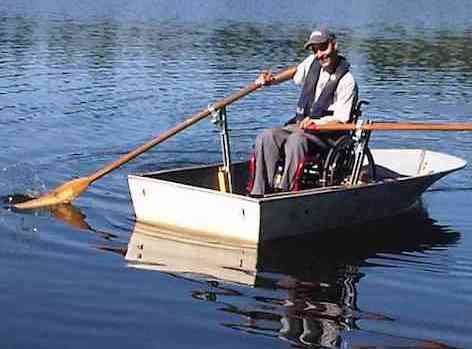Man Helps Amputee Up the Stairs, Then Returns to Build Ramp
This man didn't just carry a total stranger up some stairs – he returned the next day to build them a whole new wheelchair ramp.

Jon Pimlott is blessed with a wife, two beautiful kids, a job and a healthy body ready for life. He's also got the persistence of a blood hound.
Since 2009, under the spell of an inventor's frenzy, he has labored to give people with limited mobility the freedom to be able to float on the surface of Canada's blue-green lakes.
The spark of the idea came to him while rowing at Diver Lake Park in Nanaimo, British Columbia in May 2009. He had seen the men in wheelchairs casting their lines from the accessible fishing dock. ‘Too bad they couldn't be out bobbing in a canoe or rowing their way around the calm waters'. Then, a vision came to him: All at once he knew he could build it and it would work.
I gasp and look to the sky in amazement. I know it will work even before testing my theory.
Since then he has constructed prototype after prototype, inspired by the thought of wounded warriors and even grandfathers in their last weeks of cancer rolled out on a gurney to fish with their grandchild one last time aboard a canoe pontoon, a portable dock.
"Imagine giving your dad a boat trip, a fishing pole, sitting him under an umbrella," he swooned.
His first design was simple (and still his favorite). Take any two canoes and lay five 12-foot planks fastened together as a breakaway 5-piece dock. The wheelchairs can be rolled onto the platform (even from a shoreline) and paddlers in the canoe are stationed on each of the four corners rowing the vessel. The chair bound passenger sits atop — with a spouse, a child or a loyal dog — feeling exactly as if atop a 10×12 foot floating dock. Other models use three canoes and a trolling motor to power the makeshift catamaran.
To Jon's knowledge no one has ever built anything like this before. "I guess simplicity sometimes gets overlooked," he told the Good News Network.
"It's been amazing putting a fishing rod into the hands of someone who hasn't been on the water in 10 or 12 years," said Pimlott, who dreams of giving water access to people of modest means across Canada.
Another basic prototype for getting wheelchairs on the water uses a rowboat. Pimlott calls it the Chairower and it uses a short interior ramp descending into the hull: "Just roll on, and cast off." To develop the craft, which should easily pass national safety regulations, Jon needed to make modifications to raise the oar height using extenders.
Releasing my grasp on the transom, I watch my friend, Bert Abbott, row for the first time in 30 years. I search for words to describe the moment. I do not know if I will find them.
To find testers to help with the project, he contacted a resource group called Access Nanaimo. Now he has a whole team of testers, some with cerebral palsy, some quadriplegic. Many he calls friends now, including Paul Winkler.
Winkler, now 40, was 32 when he became paralyzed from the chest down in a diving accident and lost some of his hand function. Enjoying nature has been difficult for him while living in a wheelchair because hills are such an obstacle. Since meeting Jon he has been able to catch his first fish in eight years, saying, "It was amazing."
Pimlott has experimented with different blade sizes to come up with optimal ease of use for his new friend.
"It's so fluid and amazing the way the oars are balanced," testified Winkler. "Once I lift them out of the water, I can shift them ahead and let them fall into the water and it completes the stroke for me."
"Rowing that boat, it was as if I had no injuries."
Whether offering the Canoe Catamaran or the Chairower, Pimlott's goal is to be able to rent or sell the vessels, or create a non-profit organization to donate them. "It's untapped," Pimlott says of the future. "I'm considering a crowd funding campaign to pay for the next Chairower."
With every hour of work the inventor has devoted, visions of his friends keep him going. The college buddy who lost his mobility after a mountain biking accident; Norm Hemstreet, his first volunteer, who eagerly testing each new development. Norm now "contributes in spirit only", after his death in 2010. His estate left Jon a thousand dollars to fuel his passion for helping others. . . This project is for them.
As the second person ever to test Pimlott's inventions, Paul Winkler insists there is no stopping this man.
"He's already met so many challenges. He's come up against fines, financial burdens, family restrictions – things that the average person would give in to," Winkler said with admiration. "He's not that guy."
"He's doin' it, and his gas tank is full."
Equally important, his supporters have gas tanks to match.
– WATCH the beautiful video below
SHARE This on Social Media So That Others Can Row!
Be the first to comment